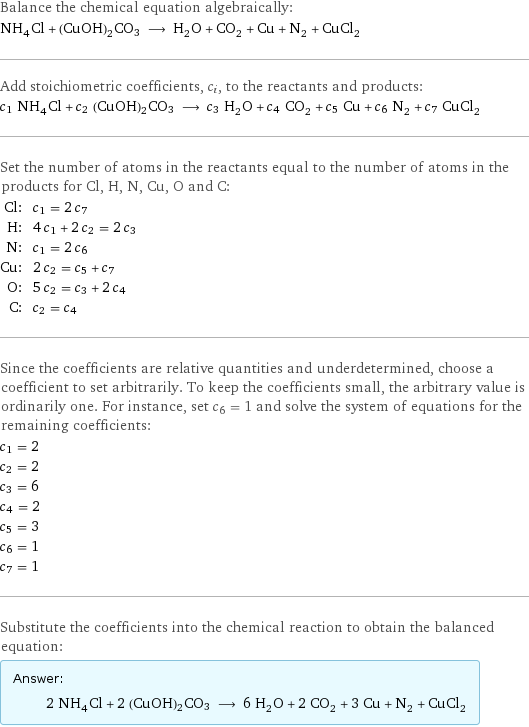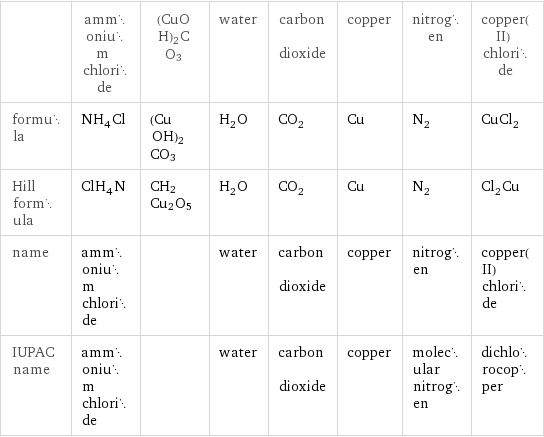Input interpretation

NH_4Cl ammonium chloride + (CuOH)2CO3 ⟶ H_2O water + CO_2 carbon dioxide + Cu copper + N_2 nitrogen + CuCl_2 copper(II) chloride
Balanced equation

Balance the chemical equation algebraically: NH_4Cl + (CuOH)2CO3 ⟶ H_2O + CO_2 + Cu + N_2 + CuCl_2 Add stoichiometric coefficients, c_i, to the reactants and products: c_1 NH_4Cl + c_2 (CuOH)2CO3 ⟶ c_3 H_2O + c_4 CO_2 + c_5 Cu + c_6 N_2 + c_7 CuCl_2 Set the number of atoms in the reactants equal to the number of atoms in the products for Cl, H, N, Cu, O and C: Cl: | c_1 = 2 c_7 H: | 4 c_1 + 2 c_2 = 2 c_3 N: | c_1 = 2 c_6 Cu: | 2 c_2 = c_5 + c_7 O: | 5 c_2 = c_3 + 2 c_4 C: | c_2 = c_4 Since the coefficients are relative quantities and underdetermined, choose a coefficient to set arbitrarily. To keep the coefficients small, the arbitrary value is ordinarily one. For instance, set c_6 = 1 and solve the system of equations for the remaining coefficients: c_1 = 2 c_2 = 2 c_3 = 6 c_4 = 2 c_5 = 3 c_6 = 1 c_7 = 1 Substitute the coefficients into the chemical reaction to obtain the balanced equation: Answer: | | 2 NH_4Cl + 2 (CuOH)2CO3 ⟶ 6 H_2O + 2 CO_2 + 3 Cu + N_2 + CuCl_2
Structures

+ (CuOH)2CO3 ⟶ + + + +
Names

ammonium chloride + (CuOH)2CO3 ⟶ water + carbon dioxide + copper + nitrogen + copper(II) chloride
Equilibrium constant
![Construct the equilibrium constant, K, expression for: NH_4Cl + (CuOH)2CO3 ⟶ H_2O + CO_2 + Cu + N_2 + CuCl_2 Plan: • Balance the chemical equation. • Determine the stoichiometric numbers. • Assemble the activity expression for each chemical species. • Use the activity expressions to build the equilibrium constant expression. Write the balanced chemical equation: 2 NH_4Cl + 2 (CuOH)2CO3 ⟶ 6 H_2O + 2 CO_2 + 3 Cu + N_2 + CuCl_2 Assign stoichiometric numbers, ν_i, using the stoichiometric coefficients, c_i, from the balanced chemical equation in the following manner: ν_i = -c_i for reactants and ν_i = c_i for products: chemical species | c_i | ν_i NH_4Cl | 2 | -2 (CuOH)2CO3 | 2 | -2 H_2O | 6 | 6 CO_2 | 2 | 2 Cu | 3 | 3 N_2 | 1 | 1 CuCl_2 | 1 | 1 Assemble the activity expressions accounting for the state of matter and ν_i: chemical species | c_i | ν_i | activity expression NH_4Cl | 2 | -2 | ([NH4Cl])^(-2) (CuOH)2CO3 | 2 | -2 | ([(CuOH)2CO3])^(-2) H_2O | 6 | 6 | ([H2O])^6 CO_2 | 2 | 2 | ([CO2])^2 Cu | 3 | 3 | ([Cu])^3 N_2 | 1 | 1 | [N2] CuCl_2 | 1 | 1 | [CuCl2] The equilibrium constant symbol in the concentration basis is: K_c Mulitply the activity expressions to arrive at the K_c expression: Answer: | | K_c = ([NH4Cl])^(-2) ([(CuOH)2CO3])^(-2) ([H2O])^6 ([CO2])^2 ([Cu])^3 [N2] [CuCl2] = (([H2O])^6 ([CO2])^2 ([Cu])^3 [N2] [CuCl2])/(([NH4Cl])^2 ([(CuOH)2CO3])^2)](../image_source/2c6b76732f1242eb9176c328f3ba4fe2.png)
Construct the equilibrium constant, K, expression for: NH_4Cl + (CuOH)2CO3 ⟶ H_2O + CO_2 + Cu + N_2 + CuCl_2 Plan: • Balance the chemical equation. • Determine the stoichiometric numbers. • Assemble the activity expression for each chemical species. • Use the activity expressions to build the equilibrium constant expression. Write the balanced chemical equation: 2 NH_4Cl + 2 (CuOH)2CO3 ⟶ 6 H_2O + 2 CO_2 + 3 Cu + N_2 + CuCl_2 Assign stoichiometric numbers, ν_i, using the stoichiometric coefficients, c_i, from the balanced chemical equation in the following manner: ν_i = -c_i for reactants and ν_i = c_i for products: chemical species | c_i | ν_i NH_4Cl | 2 | -2 (CuOH)2CO3 | 2 | -2 H_2O | 6 | 6 CO_2 | 2 | 2 Cu | 3 | 3 N_2 | 1 | 1 CuCl_2 | 1 | 1 Assemble the activity expressions accounting for the state of matter and ν_i: chemical species | c_i | ν_i | activity expression NH_4Cl | 2 | -2 | ([NH4Cl])^(-2) (CuOH)2CO3 | 2 | -2 | ([(CuOH)2CO3])^(-2) H_2O | 6 | 6 | ([H2O])^6 CO_2 | 2 | 2 | ([CO2])^2 Cu | 3 | 3 | ([Cu])^3 N_2 | 1 | 1 | [N2] CuCl_2 | 1 | 1 | [CuCl2] The equilibrium constant symbol in the concentration basis is: K_c Mulitply the activity expressions to arrive at the K_c expression: Answer: | | K_c = ([NH4Cl])^(-2) ([(CuOH)2CO3])^(-2) ([H2O])^6 ([CO2])^2 ([Cu])^3 [N2] [CuCl2] = (([H2O])^6 ([CO2])^2 ([Cu])^3 [N2] [CuCl2])/(([NH4Cl])^2 ([(CuOH)2CO3])^2)
Rate of reaction
![Construct the rate of reaction expression for: NH_4Cl + (CuOH)2CO3 ⟶ H_2O + CO_2 + Cu + N_2 + CuCl_2 Plan: • Balance the chemical equation. • Determine the stoichiometric numbers. • Assemble the rate term for each chemical species. • Write the rate of reaction expression. Write the balanced chemical equation: 2 NH_4Cl + 2 (CuOH)2CO3 ⟶ 6 H_2O + 2 CO_2 + 3 Cu + N_2 + CuCl_2 Assign stoichiometric numbers, ν_i, using the stoichiometric coefficients, c_i, from the balanced chemical equation in the following manner: ν_i = -c_i for reactants and ν_i = c_i for products: chemical species | c_i | ν_i NH_4Cl | 2 | -2 (CuOH)2CO3 | 2 | -2 H_2O | 6 | 6 CO_2 | 2 | 2 Cu | 3 | 3 N_2 | 1 | 1 CuCl_2 | 1 | 1 The rate term for each chemical species, B_i, is 1/ν_i(Δ[B_i])/(Δt) where [B_i] is the amount concentration and t is time: chemical species | c_i | ν_i | rate term NH_4Cl | 2 | -2 | -1/2 (Δ[NH4Cl])/(Δt) (CuOH)2CO3 | 2 | -2 | -1/2 (Δ[(CuOH)2CO3])/(Δt) H_2O | 6 | 6 | 1/6 (Δ[H2O])/(Δt) CO_2 | 2 | 2 | 1/2 (Δ[CO2])/(Δt) Cu | 3 | 3 | 1/3 (Δ[Cu])/(Δt) N_2 | 1 | 1 | (Δ[N2])/(Δt) CuCl_2 | 1 | 1 | (Δ[CuCl2])/(Δt) (for infinitesimal rate of change, replace Δ with d) Set the rate terms equal to each other to arrive at the rate expression: Answer: | | rate = -1/2 (Δ[NH4Cl])/(Δt) = -1/2 (Δ[(CuOH)2CO3])/(Δt) = 1/6 (Δ[H2O])/(Δt) = 1/2 (Δ[CO2])/(Δt) = 1/3 (Δ[Cu])/(Δt) = (Δ[N2])/(Δt) = (Δ[CuCl2])/(Δt) (assuming constant volume and no accumulation of intermediates or side products)](../image_source/d4f112a06ec1425718d0f67bb01513ef.png)
Construct the rate of reaction expression for: NH_4Cl + (CuOH)2CO3 ⟶ H_2O + CO_2 + Cu + N_2 + CuCl_2 Plan: • Balance the chemical equation. • Determine the stoichiometric numbers. • Assemble the rate term for each chemical species. • Write the rate of reaction expression. Write the balanced chemical equation: 2 NH_4Cl + 2 (CuOH)2CO3 ⟶ 6 H_2O + 2 CO_2 + 3 Cu + N_2 + CuCl_2 Assign stoichiometric numbers, ν_i, using the stoichiometric coefficients, c_i, from the balanced chemical equation in the following manner: ν_i = -c_i for reactants and ν_i = c_i for products: chemical species | c_i | ν_i NH_4Cl | 2 | -2 (CuOH)2CO3 | 2 | -2 H_2O | 6 | 6 CO_2 | 2 | 2 Cu | 3 | 3 N_2 | 1 | 1 CuCl_2 | 1 | 1 The rate term for each chemical species, B_i, is 1/ν_i(Δ[B_i])/(Δt) where [B_i] is the amount concentration and t is time: chemical species | c_i | ν_i | rate term NH_4Cl | 2 | -2 | -1/2 (Δ[NH4Cl])/(Δt) (CuOH)2CO3 | 2 | -2 | -1/2 (Δ[(CuOH)2CO3])/(Δt) H_2O | 6 | 6 | 1/6 (Δ[H2O])/(Δt) CO_2 | 2 | 2 | 1/2 (Δ[CO2])/(Δt) Cu | 3 | 3 | 1/3 (Δ[Cu])/(Δt) N_2 | 1 | 1 | (Δ[N2])/(Δt) CuCl_2 | 1 | 1 | (Δ[CuCl2])/(Δt) (for infinitesimal rate of change, replace Δ with d) Set the rate terms equal to each other to arrive at the rate expression: Answer: | | rate = -1/2 (Δ[NH4Cl])/(Δt) = -1/2 (Δ[(CuOH)2CO3])/(Δt) = 1/6 (Δ[H2O])/(Δt) = 1/2 (Δ[CO2])/(Δt) = 1/3 (Δ[Cu])/(Δt) = (Δ[N2])/(Δt) = (Δ[CuCl2])/(Δt) (assuming constant volume and no accumulation of intermediates or side products)
Chemical names and formulas

| ammonium chloride | (CuOH)2CO3 | water | carbon dioxide | copper | nitrogen | copper(II) chloride formula | NH_4Cl | (CuOH)2CO3 | H_2O | CO_2 | Cu | N_2 | CuCl_2 Hill formula | ClH_4N | CH2Cu2O5 | H_2O | CO_2 | Cu | N_2 | Cl_2Cu name | ammonium chloride | | water | carbon dioxide | copper | nitrogen | copper(II) chloride IUPAC name | ammonium chloride | | water | carbon dioxide | copper | molecular nitrogen | dichlorocopper